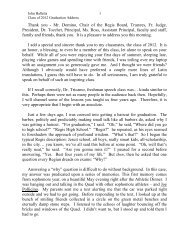RAN - Summer 2005 08.indd - Regis High School
RAN - Summer 2005 08.indd - Regis High School
RAN - Summer 2005 08.indd - Regis High School
- No tags were found...
You also want an ePaper? Increase the reach of your titles
YUMPU automatically turns print PDFs into web optimized ePapers that Google loves.
<strong>Summer</strong> <strong>2005</strong> 13<br />
April 15, Everest Base Camp, Tibet. Elev. 17,000 ft. The team<br />
arrived at base camp on April 10 after a three day jeep ride on dirt roads<br />
from Lhasa and spent several days acclimatizing. Despite being dusty, windy<br />
and cold, BC was the warmest camp on the mountain, and we would<br />
return twice during the expedition to recuperate. In the picture the yellow<br />
dome tents are Dan and Greg’s and the blue a-frame tents belong to the<br />
Sherpas and cooks. Larger dining (green) and cook (blue) tents are on the<br />
right. The team and Tibetans are weighing gear for yak loads to Advanced<br />
Base Camp (ABC). The immense north side of Everest is in the center of the<br />
picture. The Northeast Ridge to the left of the summit was the team’s line of<br />
ascent. The air at BC has half the oxygen of air at sea level.<br />
yak herder for a dzi stone necklace replica. Dzi stones are believed to have<br />
magical properties that bring good luck and ward off evil. Genuine dzi<br />
stones are hundreds, if not thousands of years old and are passed from<br />
generation to generation. Life at base camp revolved around sleeping<br />
and eating, but we also read, played chess, visited other expeditions, and<br />
explored the nearby Rongbuk Monastery.<br />
April 19, Elev. 22,000 ft. The North Col is<br />
at the top of the picture and climbers can be<br />
seen on the steep snow slopes and ice cliffs<br />
winding their way up. Our first acclimatization<br />
climb to the North Col took five hours and we<br />
were completely exhausted. Six weeks later,<br />
during our summit push, it took us under four<br />
hours and we were still fresh, the wonders of<br />
acclimatization. Our near super-human Sherpas,<br />
who live above 12,000 feet most of the year and<br />
have a genetic advantage at high altitude, would<br />
regularly carry 40 pound loads to the North Col<br />
in two and a half hours and sometimes continue<br />
to Camp 2 the same day.<br />
June 2, Summit Elev. 29,028<br />
ft. View from the summit of<br />
Everest toward Tibet, the climber<br />
in red approaching is Greg. We<br />
struggled to stay on our feet on<br />
this final section of the Northeast<br />
ridge as 60 mph crosswind gusts<br />
threatened to blow us down the<br />
corniced, 10,000 ft. Kangshung<br />
Face to the right. The winding river<br />
of ice in the middle of the picture is<br />
the East Rongbuk Glacier, our route<br />
to and from ABC.<br />
June 4, evening, Base<br />
Camp. A close-up farewell<br />
of Everest at dusk, as we<br />
packed into jeeps with our<br />
mountain of equipment<br />
for the drive back to<br />
Kathmandu.<br />
June 2, 9:30 AM, Summit. The Big<br />
Green Everest Expedition on top of the world,<br />
temperatures were below 0 F and windy. From<br />
left, Greg, Ang Mingma Sherpa (5th summit),<br />
Dan, and Mingma Dorjee Sherpa (2nd summit)<br />
with the Nepalese flag. We stayed for a little<br />
less than a half hour taking pictures and gazing<br />
at the incredible views of Nepal, Tibet and India.<br />
We could see five of the six highest mountains<br />
in the world: Kangchenjunga (3rd), Lhotse (4th),<br />
Makalu (5th), and Cho Oyu (6th). The second<br />
highest mountain in the world, K2 (28,250 ft.) is<br />
eight-hundred miles away in Northern Pakistan.
















